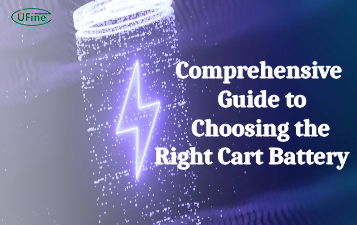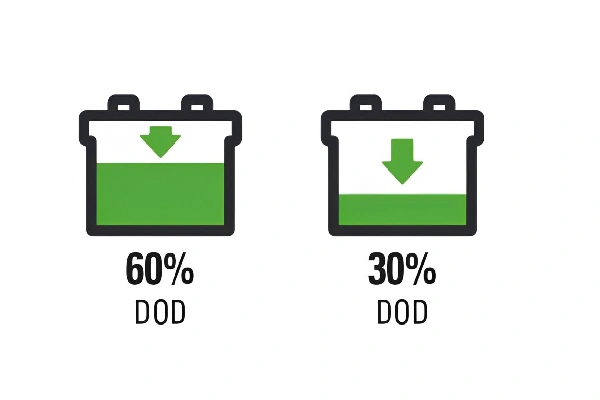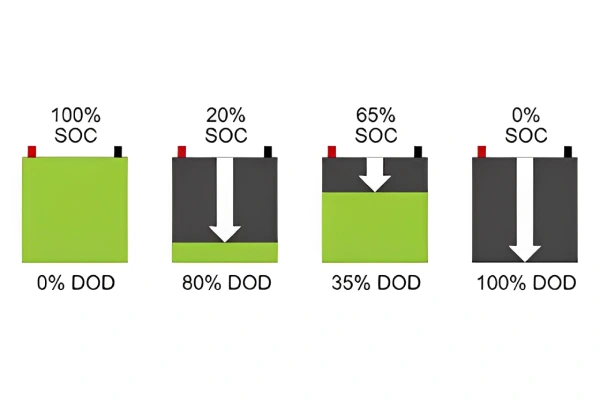Part 1. What is the depth of discharge(DoD)?
Depth of Discharge (DoD) refers to the percentage of a battery’s capacity that has been discharged relative to its maximum capacity. It is a critical parameter in rechargeable batteries, particularly in applications like electric vehicles, renewable energy storage systems, and portable electronics.
It tells you how full or empty the battery is after it has been used. For example, if a battery is only half full after use, the DoD is 50%. It helps us understand how much energy is left in the battery and how much more it can be used before recharging.
Depth of Discharge (DoD) is kind of like peeking into your car’s gas tank to see how much fuel you’ve used. It tells you how much energy has been used from a battery compared to its full capacity. So, if a battery is half empty, its DoD is 50%.
Part 2. Depth of discharge and capacity
Depth of Discharge (DoD) and capacity are different aspects of a battery’s performance.
Capacity refers to the total amount of energy a battery can store. It’s like the size of a tank that determines how much fuel it can hold.
On the other hand, DoD is about how much of that energy has been used up or discharged from the battery. It tells you how full or empty the battery is after being used, like checking how much fuel is left in the tank after driving.
Capacity is a fixed value representing the maximum energy the battery can hold, while DoD varies and shows how much of that capacity has been used.
For example, if a battery has a capacity of 100 units of energy, using 50 units means the DoD is 50%, indicating that half of the battery’s capacity has been used.
Understanding the difference between capacity and DoD helps us know the battery’s remaining energy level and how much more we can use before recharging. It’s like knowing the tank size and checking the fuel gauge in a car to see how much driving you can do before refueling.
Part 3. Depth of discharge and state of charge (SoC)
Depth of Discharge (DoD) and State of Charge (SoC) are two different ways to measure the energy level of a battery.
DoD measures how much energy has been used up or discharged from the battery, indicating how empty or full it is after being used.
On the other hand, SoC measures the current level of energy remaining in the battery, indicating how full or empty it is at a given moment.
Think of it like a glass of water. The DoD tells you how much water has been consumed from the glass, while the SoC tells you the current level of water remaining in the glass.
DoD is like looking at the glass after drinking some water to see how much is left, while SoC is like checking the glass at any time to see how full or empty it is.
Both DoD and SoC are important for understanding the battery’s energy status. DoD helps determine how much energy has been used over time. SoC provides a snapshot of the battery’s current energy level.
By considering both DoD and SoC, we can effectively manage the battery’s usage and recharge it when needed, just like knowing how much water is left in the glass and deciding when to refill it.
Part 4. Depth of discharge and cycle life
Depth of Discharge (DoD) and cycle life are two different aspects related to the performance and lifespan of a battery.
DoD refers to how much energy has been used from the battery each time it’s discharged. It tells us how empty or full the battery is after being used.
On the other hand, cycle life refers to the number of times a battery can be discharged and recharged before its performance degrade or reaches the end of its useful life.
Think of it like a car. DoD is like measuring how much fuel is used each time you drive, while cycle life is like counting the number of times you can drive the car before it starts having problems.
DoD focuses on the energy used, while cycle life focuses on the number of charge and discharge cycles a battery can go through.
Understanding both DoD and cycle life helps us manage battery usage. By monitoring the DoD, we can avoid deep discharges that can reduce cycle life and shorten the battery’s overall lifespan.
Just like taking care of a car by not driving it too much or too hard to prolong its lifetime, managing DoD and being mindful of the cycle life helps us maximize the longevity of a battery.
Part 5. Depth of discharge of different types of batteries
It’s like each battery type has its own “safe zone” for how much you can drain before recharging. So, when using different batteries, it’s important to know their specific depth of discharge limits to maximize their lifespan.
Different types of batteries have different depths of discharge limits.
1. Lithium-ion (Li-ion) battery depth of discharge
For lithium-ion (Li-ion) batteries, it is generally recommended to avoid deep discharges below 20% to prolong their lifespan. This means you shouldn’t drain them more than 80% before recharging.
2. Lead-acid battery depth of discharge
Lead-acid batteries, commonly used in automotive applications, can tolerate deeper discharges, typically up to 50% DoD, without significant impact on their longevity.
3.NiCd and NiMH battery depth of discharge
Nickel-based batteries, like nickel-cadmium (NiCd) and nickel-metal hydride (NiMH) batteries, are also more resilient to deep discharges and can handle DoDs of around 80% without severe consequences.
Part 6. How to calculate the depth of discharge?
Calculating the depth of discharge (DoD) of a battery is straightforward.
To calculate DoD, you need to know the initial capacitgy of the battery (the total energy it can hold) and the amount of energy that has been discharged from the battery.
Here’s a simplified formula to calculate the depth of discharge (DoD) of a battery:
DoD = (Discharged Energy / Initial Capacity) x 100%
- DoD is the depth of discharge
- Discharged Energy is the amount of energy that has been discharged from the batter
- Initial Capacity is the total energy capacity of the battery
First, the initial capacity of the battery, usually expressed in Amp-hours (Ah) or Watt-hours (Wh), is determined.
Next, measure or estimate the amount of energy that has been discharged from the battery, also in Ah or Wh.
To calculate the DoD, divide the discharged energy by the initial capacity and multiply by 100 to get the percentage.
For example, if a battery with a capacity of 100 Ah has been discharged by 50 Ah, the DoD would be (50 Ah / 100 Ah) x 100% = 50%.
Depth of discharge is a relative measure and can change with each discharge cycle. It’s important to recalculate DoD each time the battery is used to get an accurate understanding of its energy level.
Part 7. Depth of discharge: Is the higher the better?
No, a higher depth of discharge is not necessarily better for a battery.
In fact, it’s generally recommended to avoid high DoD levels for most batteries.
Using a higher DoD means draining more energy from the battery before recharging it. While it may provide more usage in the short term, it can have negative effects on the battery’s lifespan and overall performance.
Frequent deep discharges can contribute to accelerated battery degradation, reducing its capacity and shortening its usable life.
To maximize the longevity of a battery, it’s advisable to keep the depth of discharge within recommended limits provided by the manufacturer. This helps maintain the battery’s health, extend its cycle life, and ensure it can deliver reliable performance over an extended period.
Related Tags:
More Articles

Comprehensive Guide to Choosing the Right Cart Battery
Choosing the right cart battery ensures optimal performance and longevity. This guide covers cart battery types and helps you make an informed choice.
The Ultimate Guide to 18650 Button Top Battery
18650 button top batteries are popular for their high energy density and reliability. This guide covers their key features, usage, and maintenance tips.
The Power of Slim: Unveiling the Potential of Flat Lithium Ion Battery
Flat lithium-ion batteries power devices from phones to vehicles. This article explores their design, benefits, types, applications, charging, and safety.
The Comprehensive Guide to Battery Balancing and Battery Balancer
Battery balancing and balancers optimize performance, longevity, and safety. This guide covers techniques and tips for choosing the right balancer.
10 Key Facts About Drone Battery for 2024
Uncover crucial insights with "10 Key Facts About Drone Battery for 2024." Learn the latest trends and essential details on drone batteries.






